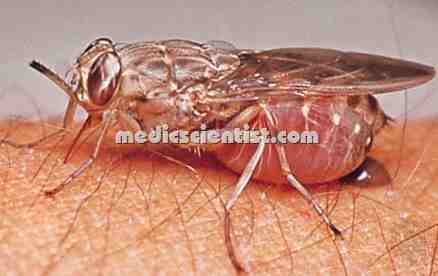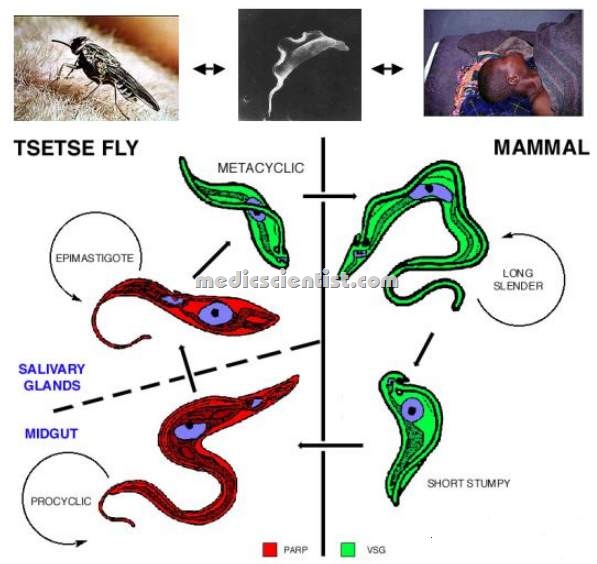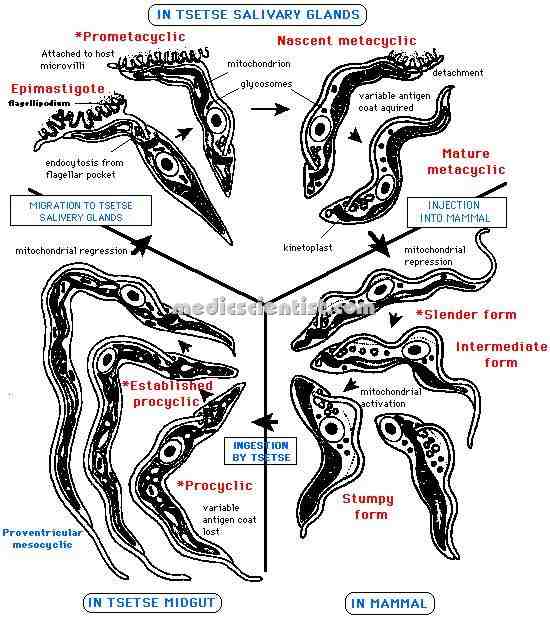SLEEPING SICKNESS OR HUMAN AFRICAN TRYPANOSOMIASIS (HAT)
Inflammation of the white and gray matter of the brain. It is almost always associated with inflammation of the meninges (meningoencephalitis) and may involve the spinal cord (encephalomyelitis). Human African trypanosomiasis (HAT) is also known as sleeping sickness. There are two forms of the disease, one of which occurs mainly in East Africa and is caused by Trypanosoma brucei rhodesiense.
 |
| SLEEPING SICKNESS OR HUMAN AFRICAN TRYPANOSOMIASIS (HAT) |
- It is caused by T brucei and transmitted to man by tsetse flies.
- These two protozoan parasites are both transmitted by the tsetse fly and have identical morphologic appearances.
- At first there is fever and lymphadenopathy which subsides.
- High fever lasts for several days followed by normal temperatures.
- Then months or years later there is neurological disease.
- T rhodesiense causes East African fever and T gambiense causes West African fever called sleeping sickness.
 |
| SLEEPING SICKNESS OR HUMAN AFRICAN fly |
Sleeping sickness is found in Africa only.
- The tsetse fly gets the infection on sucking blood from the host, the parasite multiplies in the mid-gut of the insect and migrates to salivary glands. When the insect bites another host, then the trypanosomes enter the host and cause disease.
- A trypanosomal chancre appears a week after the bite of the insect.
- There is fever, lymphadenopathy and even myocarditis.
- The lymph nodes are discrete, movable, rubbery, and non-tender
 |
| SLEEPING SICKNESS OR HUMAN AFRICAN TRYPANOSOMIASIS (HAT) |
- Winterbottom’s sign is present which is enlargement of lymph nodes of posterior cervical triangle.
- There is pruritus, rashes, malaise, headache, arthralgias, weight loss, edema, hepatomegaly, tachycardia.
- There may be leucocytosis, anaemia, thrombocytopenia.
- In the next stage there is involvement of CNS. There is sleepiness during daytime therefore called sleeping sickness.
- There is restlessness at night. Speech becomes indistinct.
- There are extrapyramidal signs like tremors, fasciculations, chorea, ataxia.
- Later there is coma and death.
- A traveler to Africa may have fever and headache and may die after return to his home.
 |
| SLEEPING SICKNESS OR HUMAN AFRICAN TRYPANOSOMIASIS (HAT) cycle |
Diagnosis of Sleeping sickness:
- · Highly motile trypanosomes can be seen in fluid from the chancre and needle aspiration of Iymphnodes, bone marrow aspiration, centrifuged CSF.
- · In CSF of patients of HAT, there is increase in pressure, increase in protein and IgM, and increased mononuclear cells.
- · PCR assay also detects trypanosomes.
- Because HAT has limited geographic distribution, an appropriate history of exposure should be identifiable.
- Several nonspecific laboratory findings may be associated with infection.
- A definitive diagnosis of infection requires the demonstration of the parasite, usually from the blood, lymph node aspirate or cerebrospinal fluid (CSF)
- Anemia is common and is thought to be due at least in part to immune-mediated hemolysis
Treatment of HAT (Human African Trypanosomiasis)
- Suramin : highly effective against stage I disease.
- All treatment regimens involve toxic or expensive drugs that are cumbersome to administer, and it is estimated that between three and five percent of those treated in the late stage of infection die from side effects of the treatment itself.
- Dose is 100-200 mg IV test dose followed by 1 gm on day 1,3,7,14,21. The drug is given in IV infusion.
- The drug has serious side effects like renal damage.
- Pentamidine.
- Eflornithine is highly effective for treatment of West African trypanosomiasis.
- Organic arsenicals : Melarsoprol is the drug of choice for East African trypanosomiasis with CNS involvement

